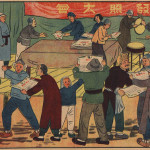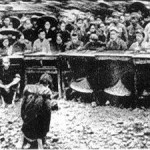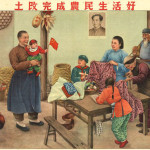
For thousands of years, the Chinese people survived by farming the land. By 1949, practically all arable land was under cultivation, and peasants constituted 85 per cent of the Chinese population. Mao Zedong was convinced that China’s peasants would be at the centre of the communist revolution that delivered them from feudalism. Under Mao’s direction, the Chinese Communist Party (CCP) developed a program of agrarian reforms. These reforms, while revolutionary, were often implemented and enforced by coercive and violent means. The Agrarian Reform Law (June 1950) was one of the communist republic’s first major policies. Its overall aim was a more equitable distribution of land, an outcome achieved by seizing land from affluent landlords and redistributing it to landless peasants. Land reform would also be the first step in China’s march toward industrialisation. In 1950 Mao congratulated the peasants, stating that it was “with their help that victory was won in the revolution, and it is again their help that will make the industrialisation of the country possible.”
The CCP’s land reform program involved turning China’s traditional social system and land ownership on its head. The Chinese word to describe this transformation was fanshen, which means to free oneself or ‘turn over the body’. Rural society was divided into new categories: landlords, who possessed large holdings and performed no manual labour; rich peasants, who owned land but worked it themselves while hiring other workers or renting land to others; middle peasants, who owned land and worked it themselves without exploiting others; poor peasants, who had very little land or equipment and had to rent land from others; and labourers, who occupied no land and had to live on meagre wages or loans. In some villages, individuals were required to wear a strip of cloth identifying their class background (landlords wore white, middle peasants yellow, poor peasants red and so forth). The state also targeted large tracts of land owned by industrialists and capitalists. This not only acquired land, it also marginalised wealthy capitalists who tended to be supporters of the Guomindang and the old regime.

The process of land reform quickly became an opportunity for retribution, as landlords were violently denounced by peasants. According to British historian Jonathan Fenby, “in this reordering of the rural world, peasants whose families had lived on or below the margin for generations got their revenge on those who had oppressed them”. The CCP legitimised and exploited these grievances, through government propaganda and the state-sanctioned ‘Speak Bitterness’ campaign. During the ‘Speak Bitterness’ campaign former landlords were forced to attend public hearings, where they were subjected to interrogation, accusation and haranguing from those they had previously exploited or mistreated. These sessions often ended with acts of violence that could range from slaps and punches to torture and execution. Banishment, imprisonment and forced and voluntary suicides were also widespread. The process of ‘Speaking Bitterness’ was devised and encouraged by Mao Zedong. It was promoted as a means for healing the wounds of the past and purging the soul – but its true purpose was to agitate class consciousness, empower the peasantry and encourage revolutionary thinking (Mao once described the sessions as part of the “education of peasants into socialism”). In June 1950 Mao described the process of land reform thus:
“Land reform in a population of over 300 million people is a vicious war. It is more arduous, more complex, more troublesome than crossing the Yangzi because our troops are 260 million peasant soldiers. This is a war for land reform, this is the most hideous class war between peasants and landlords. It is a battle to the death.”

According to some historians, the process of ‘Speaking Bitterness’ and fanshen did not occur uniformly across China. Frank Dikötter suggests that CCP activists sometimes found it difficult to penetrate prevailing Confucian attitudes and to shift old social structures and patterns. In some villages, the landlords and rich peasants were able to retain at least some status or influence. In some cases they were trained as cadres (local communist leaders), while in other areas class distinctions had scarcely existed, meaning there was little to ‘speak bitterness’ about. “The challenge was that none of these artificial class distinctions actually corresponded to the social landscape of the village,” writes Dikötter, “where most farmers often lived in roughly the same conditions”. He also argues that the CCP met with resistance because “ordinary people had qualms about persecuting and stealing from their erstwhile neighbours”, regardless of what they had done before. As a consequence, the ‘Speak Bitterness’ sessions in these areas became a charade. The villagers complied with the wishes of the party but learned how to “perform as a way to survive”. If CCP cadres discovered this indifference to fanshen it was interpreted as resistance to reform, and dealt with through indoctrination, intimidation and violence.
“The objectives of land reform were to improve the lot of the poor and to make them feel they had a stake in the country and a loyalty to the new government… But the objectives of land reform also included information and control. The CCP, by means of the cadres, obtained an insight into conditions in every part of China – and useful lists of enemies of the people. By implicating the local population in the ‘judicial’ process and the killings, control through fear was quickly established.”
William S. Morton, historian
By 1951 more than 10 million landlords had been identified and dealt with, and 40 per cent of the land was in the hands of 60 per cent of the population. At the beginning of 1953 the CCP declared China’s agrarian revolution to be complete, though in reality, more significant changes were yet to come. Statistics on violence against landlords vary significantly. It has been estimated that between one and a half million and two million former landlords died between 1947 and 1952. While the Agrarian Reform Law and land reform process helped the CCP gain peasant support, as new landowners the peasants faced more difficulties and problems. Many peasants lacked the knowledge, equipment and resources to cultivate the land productively. With the land producing less than before, there was disruption to food supply and markets that led to shortages and price rises. There was also disruption to cultural practices, including the loss of ancient agricultural ceremonies, which were replaced by party meetings and propaganda performances. Cultural artefacts like rare manuscripts, bronze coins, wooden furniture, ink paintings and ceramics were also destroyed, prompting the Ministry of Culture to order the confiscation of all rare books and antiques as a protective measure (June 1951). But the changes of the early 1950s would be supplanted by even more radical social and economic reforms in the decade to come, including the implementation of mutual aid teams, collectivisation, the People’s Communes and the disaster of the Great Leap Forward.

1. The Agrarian Reform Law (June 1950) was a communist policy that aimed to confiscate land from landlords and redistribute it to landless peasants.
2. Agrarian reform also aimed to destroy the structures and inequalities of the old social order, where people were categorised as either landlords, rich peasants, middle peasants, poor peasants or labourers.
3. In implementing land reform, Mao and the CCP encouraged the peasants to seek retribution against wealthy landlords. This led to denunciations, imprisonment, violence and executions, with as many as two million people killed between 1947 and 1952.
4. The agrarian revolution resulted in 40 per cent of the land being handed over to 60 per cent of the population. This had some adverse effects on agricultural production, as peasants came to terms with their changed situation.
5. The new society also experienced significant cultural change and disruption, as ancient agricultural festivals were replaced with party meetings and propaganda, while a great deal of cultural material like rare books and antiques were lost or destroyed.
© Alpha History 2018. Content on this page may not be republished or distributed without permission. For more information please refer to our Terms of Use.
This page was written by Rebecca Cairns. To reference this page, use the following citation:
R. Cairns, “Agrarian reform”, Alpha History, accessed [today’s date], https://alphahistory.com/chineserevolution/agrarian-reform/.
This website uses pinyin romanisations of Chinese words and names. Please refer to this page for more information.
